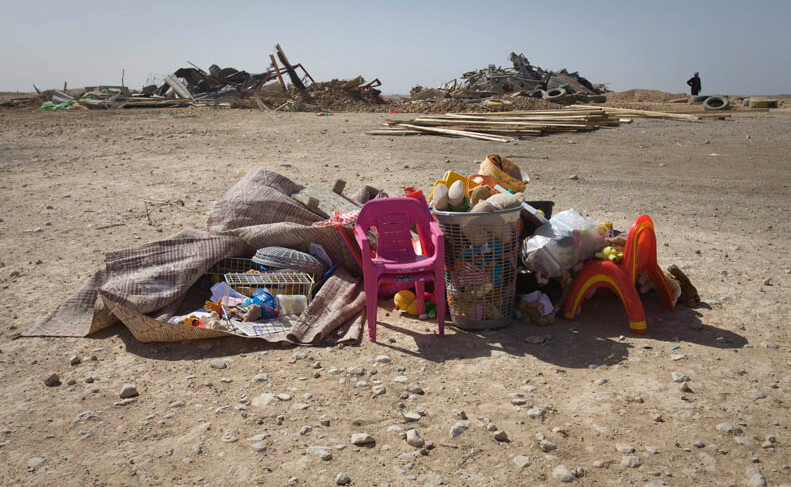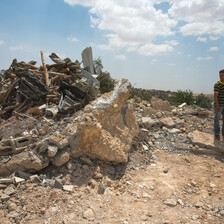The Electronic Intifada 10 May 2011

Al-Araqib village has been demolished 19 times since July 2010.
The Electronic IntifadaUMM AL-HIRAN (IPS) - As plans to demolish a Palestinian Bedouin village to make way for a new, Jewish-only town move forward in the Negev desert, the Bedouin residents have submitted a motion for the right to appeal to the Israeli high court.
Located about thirty minutes from the major town of Beer Sheva, Umm al-Hiran is one of many so-called “unrecognized” Bedouin villages peppering the Negev area that don’t receive basic services or infrastructure from the Israeli state.
In 2004, the Southern District Planning Committee unveiled its master plan, which involved completely demolishing the village — forcibly evicting 150 families and approximately 1,000 residents — and building the Jewish community of Hiran in its place.
After several structures in the village had been demolished, Umm al-Hiran residents and representatives from Adalah, the Legal Center for Arab Minority Rights in Israel, and Bimkom, a group of Israeli planners and architects, submitted an appeal to the Beer Sheva Magistrates’ Court in 2008 to stop further destruction.
To date, both the Beer Sheva Magistrates’ Court and the Beer Sheva District Court have rejected the residents’ case, ruling that neither court had the legal authority to deal with the matter.
“We hope that the high court will give us permission to appeal and then we will be able to claim to the merits of the issues,” Adalah Attorney Suhad Bishara, who is representing the villagers, told IPS.
“The outcome of this [District Court] ruling is that the State of Israel has the legal basis, according to the interpretation of the court, to hold a system of apartheid. You are asking to move a community, to evacuate a whole village, not for urgent public need but because you want another community to live there. It doesn’t make any sense,” Bishara said.
Umm al-Hiran was built in 1956 shortly after the Israeli military had evicted the Bedouin from their homes in the Wadi Zuballa area of the Negev. This was the third time that Umm al-Hiran residents — who at the time lived under Israeli military rule — had been forcibly transferred.
In a 20 April press release, Adalah stated that “At the time, the residents received assurances from the military governor that this move would be the last time they would be forced to leave their village.”
Today, only an easily missed dirt road leads residents and visitors into Umm al-Hiran, where cement and brick homes sit perched on a hillside overlooking a narrow valley, and animal pens, olive tree orchards and water tanks intersperse village lands.
“Umm al-Hiran was founded sixty years ago,” Umm al-Hiran resident Salim Abu al-Qian told IPS. “Now there is no electricity, no water. There is a difficult policy from the government to cut the water, just to force us to leave Umm al-Hiran.”
Approximately 90,000 Bedouin citizens of Israel live in similar conditions in “unrecognized” villages throughout the Negev. Since the Israeli government views the residents of these villages as illegal squatters, every community is at risk of being demolished.
The “unrecognized” Bedouin village of al-Araqib — only a few minutes from Umm al-Hiran — for instance, has been razed to the ground 19 times since July 2010. This is despite the fact that court proceedings are still under way to determine land ownership between the residents and the Israeli state.
According to Oren Yiftachel, a professor of geography and environmental development at Ben Gurion University of the Negev in Beer Sheva, this wave of destruction signals the Israeli government’s larger plan to concentrate Bedouin citizens on as little land as possible in the Negev, and build Jewish communities there instead.
“The goal of the state is still, within the possibilities that it has, to limit the Bedouins to confined areas and to Judaize the rest. Judaizing the land, Judaizing the resources, Judaizing the power, and seeing any shadow of (a) claim to equality as a threat to this construction of a Jewish state,” Yiftachel said. He added that in the case of Umm al-Hiran, the planned Jewish community of Hiran — which will accommodate between 7,000 and 10,000 people — could be built without displacing the residents of Umm al-Hiran.
“It would mean moving the plan of the Jewish village 300 meters, which of course is possible because it hasn’t been built yet. We don’t think there is a need of Jewish settlement there. But if they want to do it, they don’t need to kick out Umm al-Hiran,” Yiftachel said.
The Israeli land authorities want Umm al-Hiran residents to move to the nearby, state-built Bedouin town of Hura, which has a population of approximately 16,000 people. For Abu al-Qian, however, who has lived in Umm al-Hiran his entire life, the reality is that Hura doesn’t meet his or his neighbors’ needs.
“We are an agricultural village and farming village. Life in Hura is not suitable for my lifestyle. I want to live where I live today. We want the government to stop discriminating against us and to get our rights,” Abu al-Qian told IPS.
“[Umm al-Hiran] is my village. I was born there. I will stay there. I won’t leave. I will try to defend my village because the alternative solution that they give us isn’t suitable.”
All rights reserved, IPS - Inter Press Service (2011). Total or partial publication, retransmission or sale forbidden.





